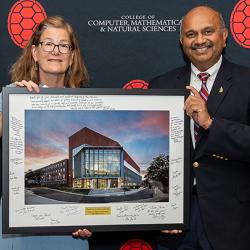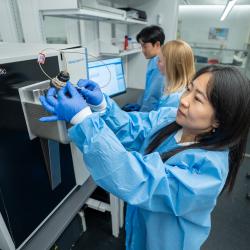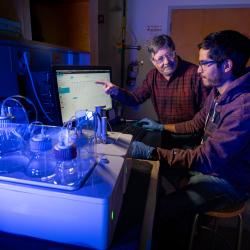Frit, Fume Hoods and Flexibility
Along Stadium Drive on the east side of campus, construction crews are laying the groundwork for the University of Maryland’s new $116 million Chemistry Building. For a powerhouse department aiming to become one of the nation’s top 10 programs, this new state-of-the-art facility will support the department’s cutting-edge research and innovation in advanced materials, energy storage and sustainability, drug discovery and delivery, and quantum chemistry well into the future.
“It sends a message that UMD really cares about doing high-quality research in chemistry and biochemistry—that we’re willing to put in the resources,” said Associate Professor Efrain Rodriguez, who served on the planning committee for the new building. “We need this building to move forward, and this sends a signal to other institutions that we’re willing to do that.”
The design of the new building reflects ideas and recommendations that emerged from hundreds of hours of meetings with the department’s building advisory committee, tours of cutting-edge chemistry buildings at other universities, and a forum with students, faculty, staff and other campus stakeholders.
The overall goal: to create a facility that will catalyze a new era for chemistry and biochemistry at UMD.
“The intent was to help support the department’s top-10 aspiration with a high-quality innovation environment because we want to attract the best and brightest in research,” said architect Craig Spangler, principal-in-charge and lead designer for the project from Ballinger. “And we definitely wanted it to be a flexible and enduring building.”
By the numbers
Occupying the site of the chemistry complex’s now-demolished Wing 1, the new six-floor structure will include 34 research labs, two core research facilities, 13 meeting and huddle rooms, and 13,000 square feet of technology-enhanced office space. Altogether, the building will encompass 105,130 square feet of purpose-driven research and learning areas:
- 55% dedicated to research labs
- 25% dedicated to research workspaces
- 20% dedicated to community space
The building will provide urgently needed workstations for students and junior researchers, including:
- 97 for graduate students
- 36 for undergraduate students
- 32 for postdoctoral associates
- 5 for research assistants
Plus a flexible configuration to add 97 workstations to achieve target occupancy
All that adds up to a lot of building materials. Think bricks—138,000 of them. And a lot of glass, approximately 25,800 square feet in all. Because sustainability and energy conservation are a priority for the building, many materials will be locally sourced. The 10,800 square feet of exterior glass will use a patterned, ceramic frit coating to reduce glare and solar heat gain. And on the building’s exterior, 2,400 linear feet of solar shading will help control indoor temperatures.
“We have a lot of glass to create a vibrant internal environment, so we want to manage the heat gain,” Spangler explained. “The solar shading enables you to have the exterior transparency while minimizing the heat hitting the glass. The shades are permanent and act as fins that help reduce some of the heat gain.”
The building’s energy-friendly features are designed to meet the university-mandated LEED Silver certification.
“We’ve focused on the things that matter most in terms of conserving energy,” Spangler said.
Control and stability in the labs
Systems and infrastructure in the new building’s research areas are designed to meet the specific needs of faculty members doing innovative research. For Rodriguez, who creates sustainable advanced materials, that means being able to control temperature and other conditions in the lab with pinpoint accuracy.
“We do a lot of work that’s air- and moisture-sensitive when synthesizing new compounds,” Rodriguez said. “The climate control of the space in the new building is really precise and that will allow us to do experiments that we haven’t done before.”
For Associate Professor Peter Nemes and others advancing biomolecular science, the new state-of-the-art labs will provide the stability and environmental controls needed for the ultra-sensitive instruments that are critical to their work.
“The new building will ensure a high-quality research environment and infrastructure that have become essential to high-end instruments,” Nemes explained. “In my laboratories, the high-resolution mass spectrometers will be delighted to operate on stable and controlled temperature, stable and uninterrupted power, and dust-free research spaces.”
In the lowest level of the building, a specially engineered slab-on-grade floor will keep vibrations at a minimum, a factor critical to UMD’s groundbreaking research in quantum chemistry.
“Measurements of chemical properties in the quantum limit often require highly sensitive, ultra-precise techniques that can be disrupted by vibrations transmitted through the floors from mechanical equipment or even footsteps,” said Assistant Professor Leah Dodson, whose research focuses on quantum chemistry and astrochemistry. “The new Chemistry Building was planned for such experiments—our floors there will have the same vibration resistance as the surgical suites required for neurosurgery.”
Throughout the new building, research areas are as flexible as they are innovative.
“The most important part is we’ve created kind of a standard module that can come in different flavors with plug-and-play ability of putting more or less fume hoods in and moving benches around, as well as being plug-and-play in terms of utilities,” Spangler explained. “We’ve got a very flexible environment that can change out to accommodate the variety of research that’s occurring in the building.”
Encouraging interaction and collaboration
Work areas throughout the new building have been designed for transparency, connecting faculty and students with their labs and workspaces, the outdoors and each other.
“We have abundant transparency between the workstations and the lab, so when you’re in the workstations you can look through the labs and to the outside,” Spangler said. “We’ve created cohorts that are open workstation zones divided by a series of faculty offices so there are smaller research groupings within an open environment.”
Rather than isolating researchers from each other, the overall design encourages interaction and collaboration, a key component of the kind of research UMD chemists and biochemists do today.
“Some of my best research ideas were born from random conversations on a hallway,” Nemes noted. “The new Chemistry Building will provide open spaces and conference rooms to discuss research results, set next goals, evaluate data and brainstorm novel ideas.”
The design of the new Chemistry Building pushes the capabilities of research without compromising green features. Along with state-of the-art cooling, ventilation and heating, the building will also include LED lighting, high-efficiency plumbing fixtures and stormwater management, including a bioswale, to concentrate and convey runoff. Even the fume hoods—66 in all—are designed for greater efficiency.
“In a building like this, the fume hoods are the thing that can require an extensive amount of energy and managing this becomes a really important thing,” Spangler explained. “We have a high-performance glycol heating loop that extracts energy from the outgoing air to precondition incoming air, and that’s a major energy savings.”
Also included in the building is a state-of-the-art helium recovery system—a green feature many research facilities don’t have.
“Helium is a resource that’s being depleted, and recovering that helium for re-use is very important,” Spangler said.
Another special feature in the new Chemistry Building is the grand colloquia and events venue. It’s a conference room unlike any other at UMD, according to Spangler, who has designed three other buildings on campus and just happens to be an alumnus.
“This is a more intimate place where scholars from all over the world can engage with the researchers on campus. It’s on the Regents Drive level, which is important because it connects with all the wings of the chemistry complex,” Spangler explained. “In that room will be an extraordinarily high-definition screen so that the scientists can look at images with a very magnified capability.”
From cool conferencing spaces to plug-and-play workspace modules and state-of-the-art infrastructure, the new Chemistry Building sets a new standard for research, education and collaboration, taking research and discovery into a whole new era—by design.
“We believe the folks in this new building are going to change our world,” Spangler said. “And we believe in giving them spaces that inspire them to do their very best.”
Written by Leslie Miller







